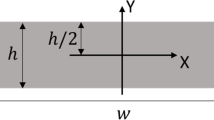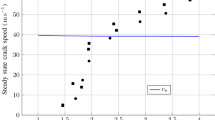Abstract
Dynamic fracture is generally addressed as an isothermal phenomenon. When specific phenomena such as shear band formation and propagation are involved, the analyses include thermomechanical conversion of strain and/or fracture energy into heat (thermoplasticity). In this case, it has been shown that very significant temperature rises can develop which cause softening of the crack-tip material. In these works, thermoelastic temperature changes at the tip of the crack are implicitly neglected. In a recent work, we have questioned this issue and shown that for a stationary crack subjected to transient loading, adiabatic thermoelastic effects were noticeable, thus causing a large temperature drop in the elastic zone surrounding the crack-tip (Rittel, 1998). In the present work, we pursue this line of investigation by presenting additional experimental results about temperature changes ahead of a dynamically loaded crack in commercial polymethylmethacrylate. We investigate mode I and mode II loading configurations. We observe, as expected, that the temperature drops for mode I loading while it rises for the mode II case. In each case, the crack initiates during the phase where the temperature changes (drop or rise). While showing that thermoelastic aspects of fracture should certainly be taken into account, the present results indicate that thermomechanical aspects in general should not be overlooked when addressing dynamic crack initiation.
Similar content being viewed by others
References
Aoki, S. and Kimura, T. (1993). Finite element study of the optical method of caustic for measuring impact fracture toughness. Journal of Mechanics and Physics of Solids 41(3), 413-425.
Boley, B.A. and Weiner, J.H. (1960). Theory of thermal stresses, J. Wiley and Sons, New York, NY.
Carslaw, H.S. and Jaeger, J.C. (1959). Conduction of heat in solids, Oxford University Press, Oxford, U.K.
Dillon, O.W., Jr., (1963). Coupled thermoplasticity, Journal of Mechanics and Physics of Solids 11(21), 21-33.
Dillon, O.W., Jr. and Tauchert, T.R. (1966). The experimental technique for observing the temperatures due to the coupled thermoelastic effects. International Journal of Solids and Structures 2, 385-391.
Freund, L.B. (1990). Dynamic Fracture Mechanics, Cambridge University Press, Cambridge.
Fuller, K.N.G., Fox, P.G. and Field, J.E. (1975). The temperature rise at the tip of a fast-moving crack in glassy polymers. Proceedings of the Royal Society A341, 537-557.
Kalthoff, J.F. (1988). Shadow optical analysis of dynamic fracture. Optical Engineering 27, 835-840.
Kobayachi, A.S. (1987). Handbook on Experimental Mechanics, Prentice-Hall, Inc., Englewood Cliffs NJ.
Lee, Y.J. and Freund, L.B. (1990). Fracture initiation due to asymmetric impact loading of an edge cracked plate Journal of Applied Mechanics 57, 104-111.
H. Maigre and D. Rittel. (1993). Mixed-mode quantification for dynamic fracture initiation: Application to the compact compression specimen. International Journal of Solids and Structures 30(23), 3233-3244.
Maigre, H. and Rittel, D. (1996). Dynamic fracture detection using the force-displacement reciprocity: Application to the compact compression specimen. International Journal of Fracture 73(1), 67-79.
Marchand, A. and Duffy, J. (1988). An experimental study of the formation process of adiabatic shear bands in a structural steel. Journal of Mechanics and Physics of Solids 36(3), 251-283.
Mason, J.J., Lambros, J. and Rosakis, A.J. (1992). The use of a coherent gradient sensor in dynamic mixed-mode fracture mechanics experiments. Journal of Mechanics and Physics of Solids 40(3), 641-661.
Mason, J.J., Rosakis, A.J. and Ravichandran, G. (1993). On the strain and strain rate dependence of the fracture of plastic work converted into heat and full field measurements of the dynamic deformation field around a growing adiabatic shear band. Proceedings of the US Army Symposium on Solid Mechanics.
Meyers, M.A. (1994). Dynamic Behaviour of Materials. J. Wiley and Sons, New York, NY.
Ravi Chandar, K. (1995). On the failure mode transitions in polycarbonate under dynamic mixed mode loading. International Journal of Solids and Structures 32(6/7), 925-938.
Rittel, D. (1998). Experimental investigation of transient thermoelastic effects in dynamic fracture. International Journal of Solids and Structures 35(22), 2959-2973.
Rittel, D., Levin, R. and Maigre, H. (1997a). On dynamic crack initiation in polycarbonate under mixed-mode loading. Mechanics Research Communications 24(1), 57-64.
Rittel, D., Levin, R. and Maigre, H. (1997b). The influence of mode-mixity on dynamic failure mode transitions in polycarbonate. Journal de Physique France 7, Colloque C3, (1997), 861-866.
Rittel, D. and Maigre, H. (1996). An investigation of dynamic crack initiation in PMMA. Mechanics of Materials 23, 229-239.
Rittel, D., Maigre, H. and Bui, H.D. (1992). A new method for dynamic fracture toughness testing. Scripta Metallurgica et Materialia 26, 1593-1598.
Taylor, G.I. and Quinney, H. (1934). The latent energy remaining in a metal after cold working. Proceedings of the Royal Society A143, 307-326.
Weichert, R. and Schönert, K., (1978). Heat generation at the tip of a moving crack. Journal of Mechanics and Physics of Solids 26, 151-161.
Zehnder, A.T., and Rosakis, A.J. (1991). On the temperature distribution at the vicinity of dynamically propagating cracks in 4340 steel. Journal of Mechanics and Physics of Solids 39(3), 385-415.
Zhou, M., Rosakis, A.J. and Ravichandran, G. (1996). Dynamically propagating shear bands in impact-loaded prenotched plates. I — Experimental investigations of temperature signatures and propagation speed. Journal of Mechanics and Physics of Solids 44(6), 981-1006.
Author information
Authors and Affiliations
Rights and permissions
About this article
Cite this article
Rittel, D. Thermomechanical aspects of dynamic crack initiation. International Journal of Fracture 99, 201–212 (1999). https://doi.org/10.1023/A:1018616917384
Issue Date:
DOI: https://doi.org/10.1023/A:1018616917384




